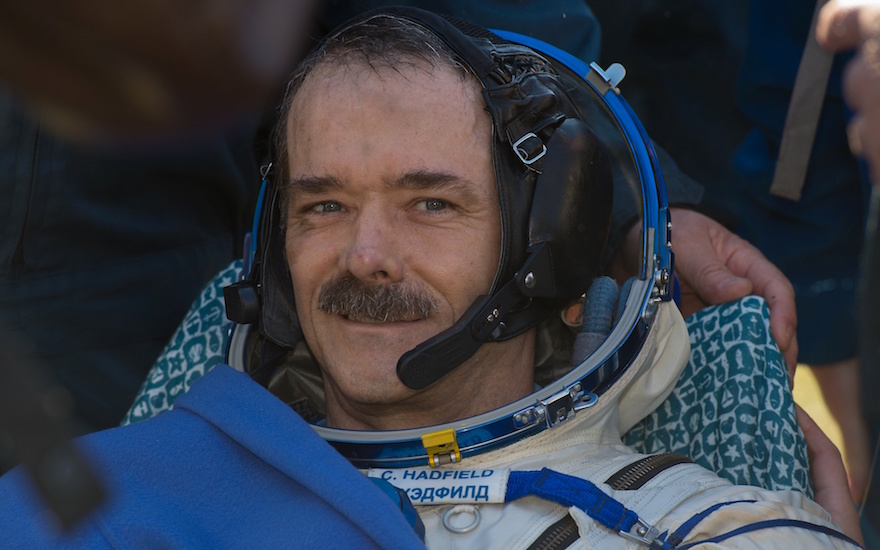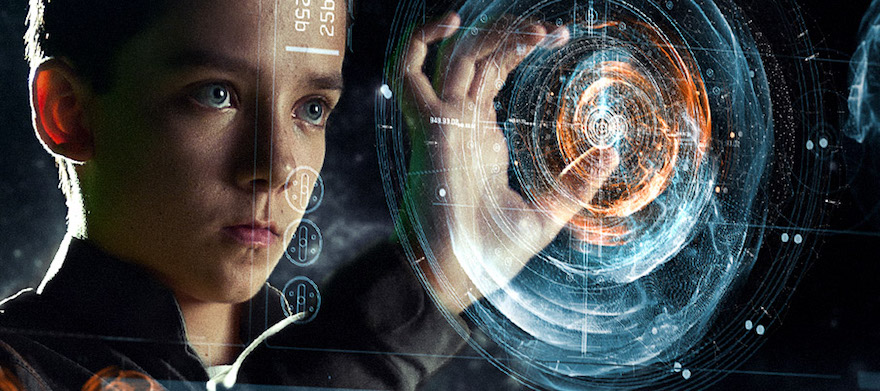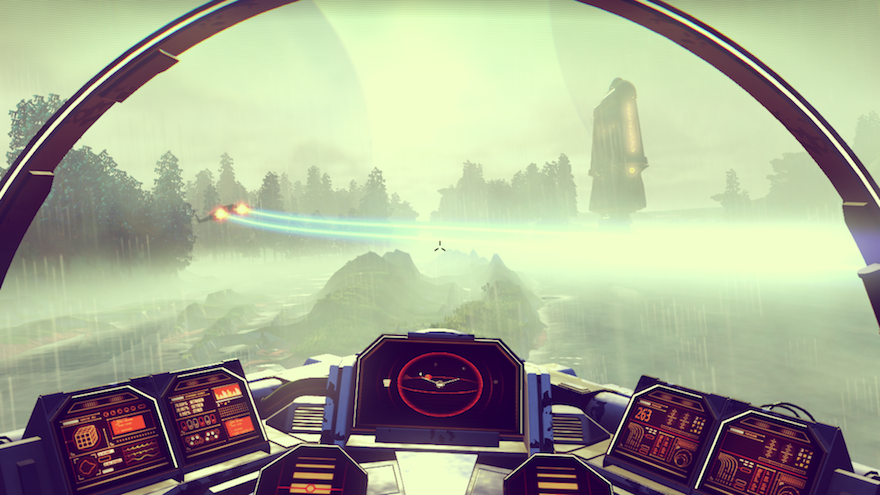“There is only one essential question: What’s the next thing that could kill me? Focusing on that thing, whatever it is, is how you stay alive.” Ground Control, this is Commander Chris Hadfield describing his experiences as an astronaut and career as a pilot for the Canadian Forces, North American Aerospace Defense Command (NORAD), U.S. Air Force Test Pilot School (TPS) and U.S. Navy. To get the full story, just read An Astronaut’s Guide to Life on Earth (2013). It’s incredible.
In order to successfully complete three space missions, two space walks, and live aboard the International Space Station (ISS) for six months, Hadfield had to train extensively for years in Earth-based simulations that gradually prepared him for the thrills and perils of space exploration. As with any astronaut, he had to spend a lot of time in virtual realities, working with realistic simulations that imitate the challenges that might be faced in space. Yes, he had to play videogames.

Chris Hadfield after landing by jasbond007
In order to understand anything at all of the universe, the journey must begin by creating simulations right here on Earth that are informed by scientific research. In the meantime, space exploration is becoming more accessible to all of humanity as futuristic companies like Blue Origin and Virgin Galactic are paving the way for civilian access to space. There is a whole orbiting infrastructure of space hotels, asteroid mining initiatives, and 3D-printing in space that is being developed, and it is inevitable that virtual simulations will be needed in order to launch this Earthling dream as a reality.
Hadfield spoke to the importance of astronaut simulations in a Fresh Air interview with Terry Gross once. “It’s not like astronauts are braver than other people; we’re just meticulously prepared,” he said. “We dissect what it is that’s going to scare us, and what it is that is a threat to us and then we practice over and over again so that the natural irrational fear is neutralized.” In other words, it takes years on Earth to prepare for a single space mission. There is so much to learn. Hadfield spent about 50 whole days practicing procedures in the world’s largest pool at the Neutral Buoyancy Laboratory before his very first space walk. This gargantuan simulation consists of a large pool that is 200 feet long and 40 feet deep, containing 6.2 million gallons of water, where space station replicas are housed so that astronauts and astronaut candidates can get a sense of working in weightlessness while grounded on Earth.
Hadfield also describes playing with part-task-trainers or PTTs that are run by a simulation instructor, learning to prioritize tasks as various systems in a simulated mission begin to fail. According to Hadfield, the most complex moments of a mission are during launch and deorbit burn. “We spend our days studying and simulating experiences we may never actually have. It’s all pretend, really, but we are learning. And that, I think, is the point: learning.”
It’s almost like a situation out of Ender’s Game (2013)—riding that blurred line between virtual simulations and true reality, not knowing which simulation or experience might actually end up saving lives during a mission. This is why there are also contingency sims or death sims that force the astronauts and everybody on Earth responsible for the mission—administrators, doctors, NASA media relations, the astronaut’s colleagues and family—to work through the sordid details of a death or fatal injury onboard the ISS or in orbit in a very practical manner. It is always important to prepare for the worst-case scenario. There is even an unusual power in negative-thinking according to Hadfield, gaining the ability to quickly and efficiently anticipate all the ways that a mission could possibly fail. This means preparing for just about anything, enabling each astronaut with the confidence to make quick judgement calls whenever it matters most.

Hadfield, too, speaks to the importance of failure in sims in his book. “Sometimes a sim is a proving ground where you demonstrate how well-rounded your capabilities are,” he says, “but more often, it’s a crucible where you identify gaps in your knowledge and encounter domino effects that simply never occurred to you before.” This is where true creativity is needed—thinking up all kinds of systems failures and actually recreating these ideas as effective simulations. We, as a species, have no problem with this particular task. After all, this is what’s already happening on a large-scale as all of humanity anticipates future Mars missions. Look at The Martian (2011), a bestselling novel turned award-winning sci-fi film that captivated audiences with Mark Watney’s ingenuity in surviving the tough Martian climate. Both the book and the film draw upon real scientific knowledge of Mars, as well as an understanding of current technologies being developed for future missions in order to create an imagined yet realistic simulation of a Mars mission.
It is this type of originality that will be needed in creating simulated scenarios for future deep space missions. Maybe future NASA job announcements will read somewhat differently than in the past as game makers are moved into high demand within scientific fields, bringing space exploration to life with virtual reality possibilities. In fact, NASA has already teamed up with Microsoft to create the Microsoft HoloLens, a virtual reality tool that gathers real Mars data from the Curiosity rover and then creates a 3D simulation of Martian terrain. It’s part of a line that’s being drawn towards the value of videogames that can both accurately simulate space exploration missions and reach a wide audience.
It should be unsurprising, then, to find out that NASA is already trying to excite and educate the younger generations with efforts like Moonbase Alpha (2010), where players must face the threat of a meteorite that damages the life support infrastructure on a lunar settlement, working with other astronauts to solve intense challenges within a short time span. There’s also the Station Spacewalk Game (2010) that allows players to conduct Extravehicular Activities (EVA) that real astronauts have accomplished in the past while also exploring the ISS via realistic 3D simulations. The Kennedy Space Center at Cape Canaveral takes gaming and simulating further with a roller-coaster-like launch simulation. Players are escorted into their seats and strapped in for the ride while being briefed about the dangers of a typical launch before being tilted backwards in preparation for blast-off, anticipating and facing the roar of the engine and forces that make it an unforgettable experience.
There is also what seems to be a whole movement right now that’s dedicated to creating creating space simulation games that capture the off-world thrill of it all. Space Engineers (2013) focuses on nuts-and-bolts situations and fixing up a virtual spaceship. While Kerbal Space Program (2015) is probably the closest right now to a real space mission in which players are subjected to the stresses of real science; launching rockets and trying to avoid deadly explosions. And for all the dreamers out there, the upcoming No Man’s Sky is probably the best bet, providing stunning visuals of celestial bodies and far-away galaxies and planets, granting players the freedom to explore an entire universe and chart its many ecosystems.

It seems that the major difference between Commander Hadfield’s experiences with simulations and those of subsequent generations will be accessibility and familiarity. Videogames are steadily closing the gap between a person’s interest in exploring space and them jumping into a realistic simulation of a space mission. Maybe the next Neil Armstrong or Mae Jemison will grow up inspired by these virtual realities, landing on Mars from the comfort of their couch before transforming that childhood dream into a beautiful reality.
